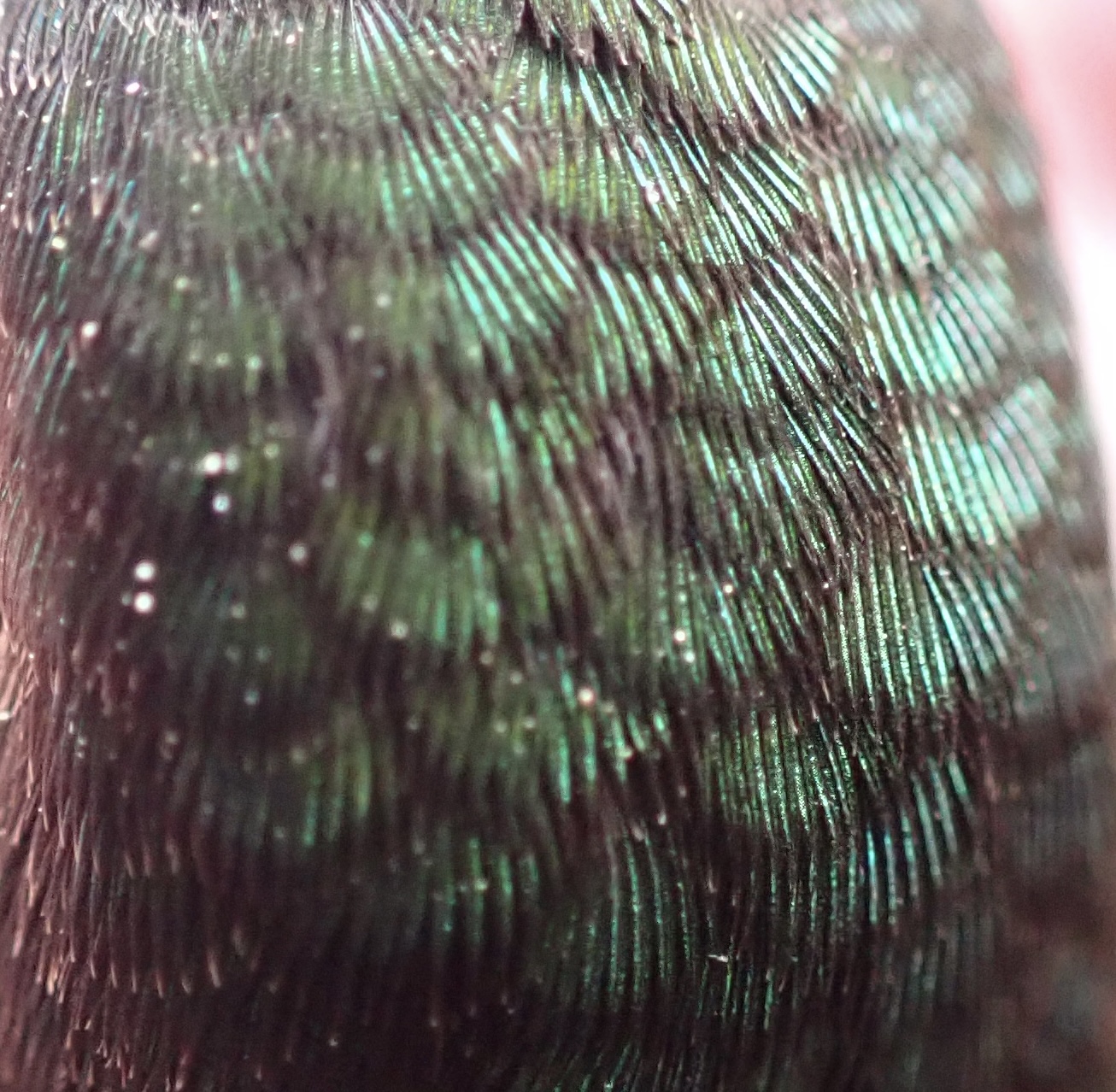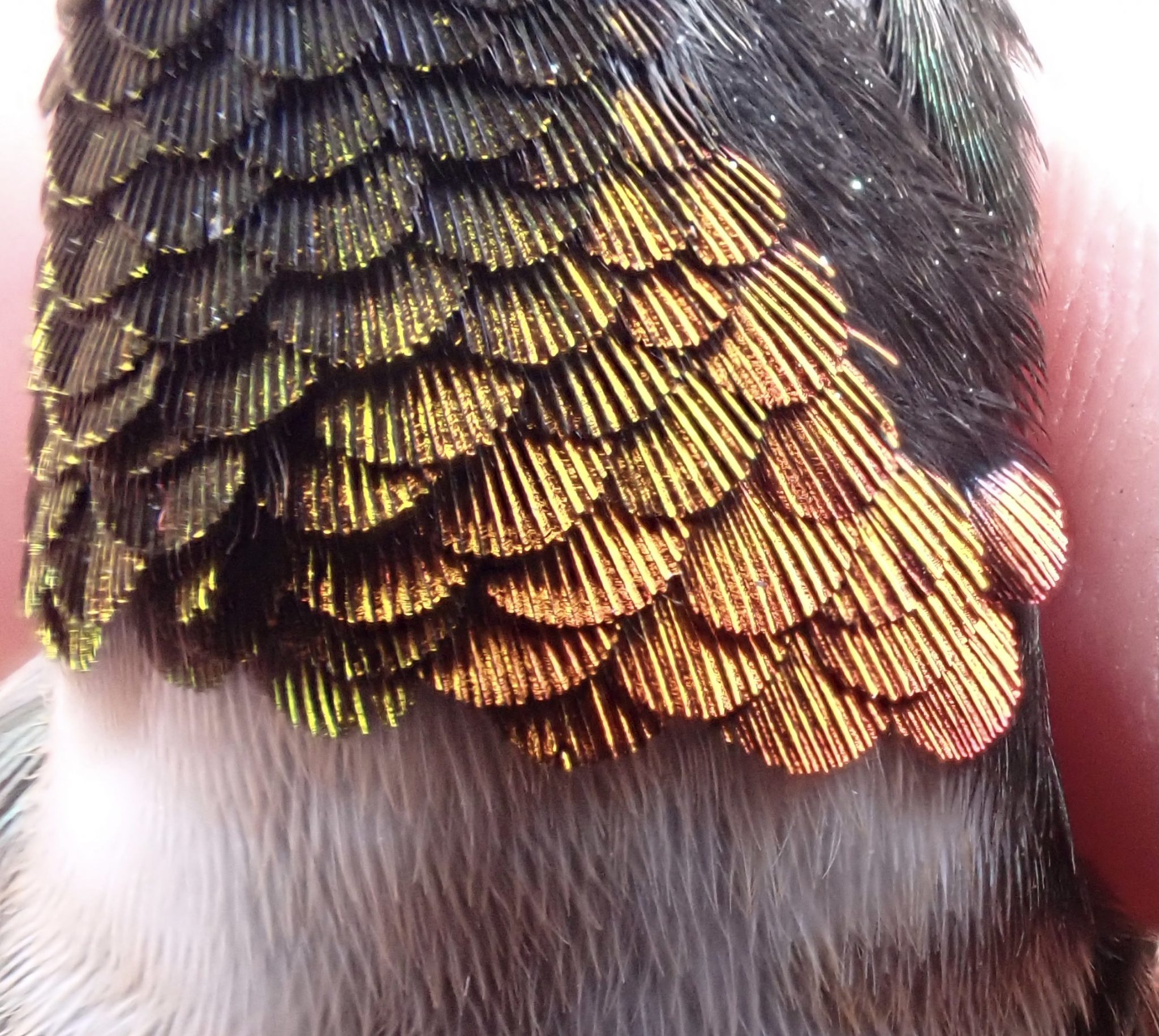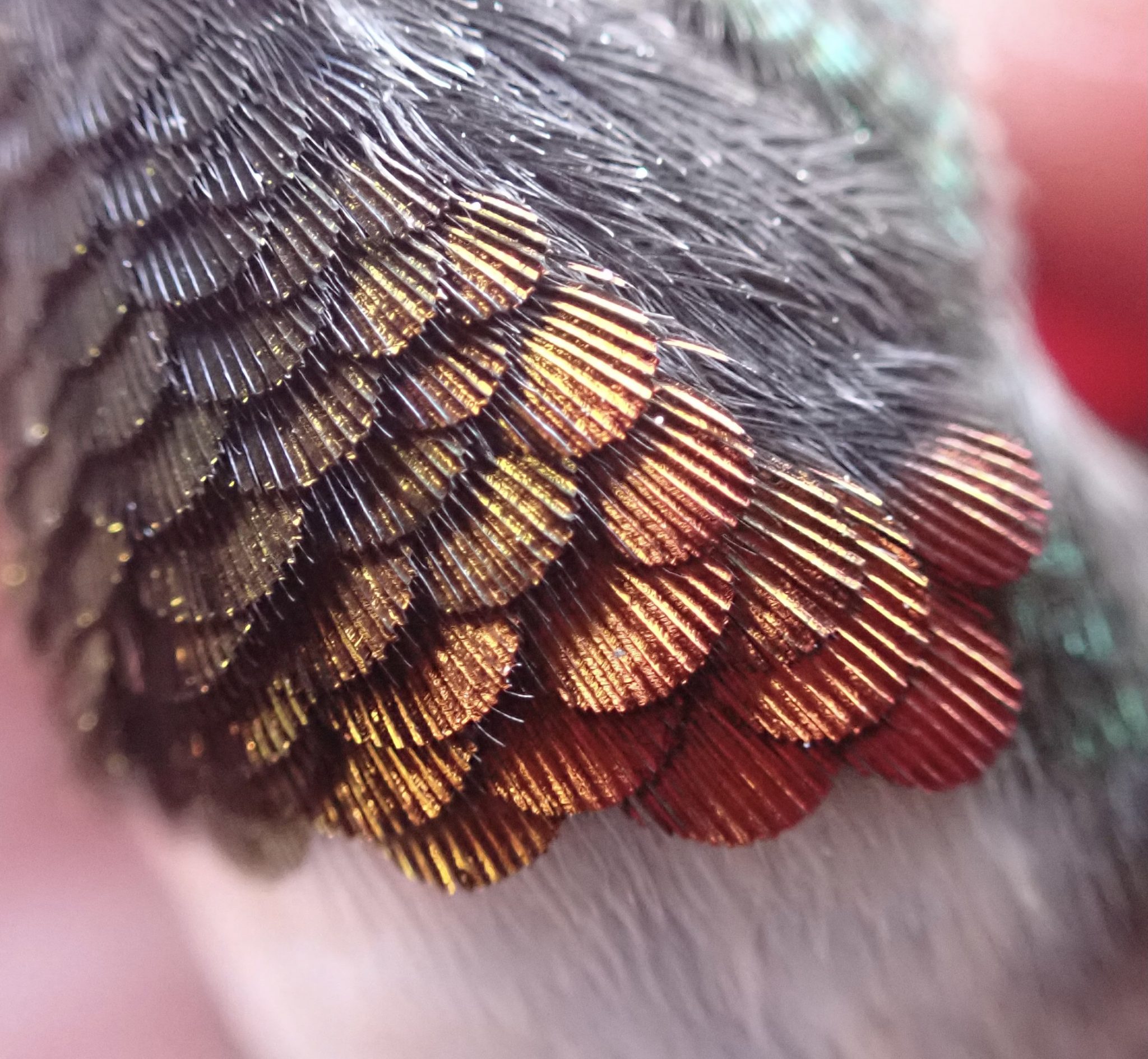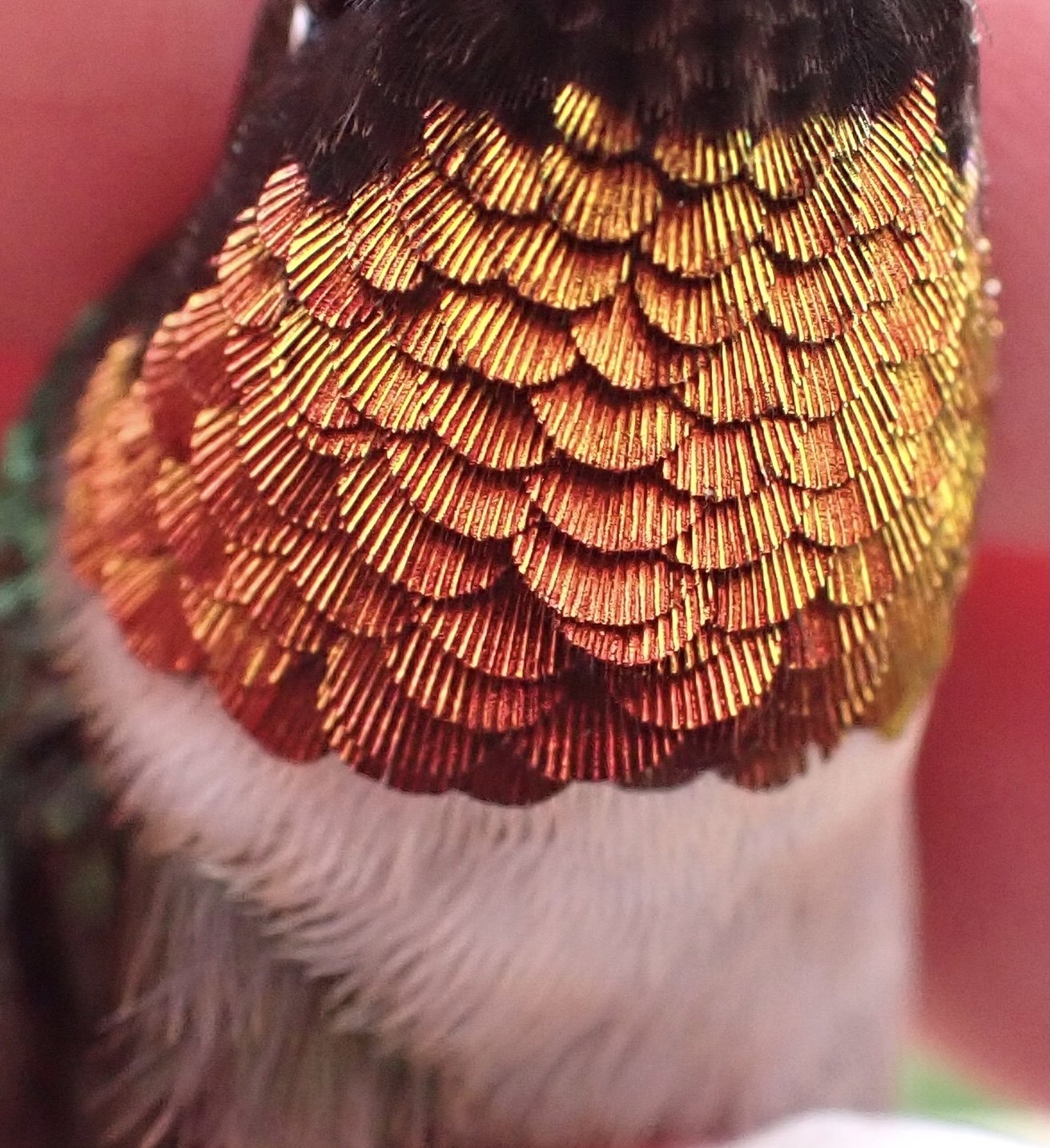We’re saying farewell to the Ruby-throated Hummingbirds this month…like we do to the autumn leaves. These photos were taken by Erin Talmage of a Ruby-throated Hummingbird male’s neck and back feathers, using different angles of light.
Through the Window: August 2021

We continued to be light on the feeding this month, as we tried to do our bit to reduce or limit the spread of the mysterious disease we’d heard of—encouraging the equivalent of “social distancing” for birds. This disease had not been reported in Vermont. By the end of the month, we had resumed a very limiting feeding schedule. Continue reading “Through the Window: August 2021”
Through the Window: July 2021
![[Great Crested Flycatcher on office window netting. May 2019]](https://cpanel3.neonova.net/~wwwbirdsofvt/wpsite2017/wp-content/uploads/2019/06/Great-crested-flycatcher-office-window-kjt-May2109-e1560095402160-188x300.jpg)
We stopped feeding birds this month, as we waited to hear more about a mysterious disease affecting eyes (at least) in birds in the mid-west/mid-Atlantic regions. However, we did see rather a good selection of birds as usual until then!
Continue reading “Through the Window: July 2021”
Expanding Voices: perspectives on birding | 2021 community art show
Our 2021 art show, Expanding Voices, explores and reflects the past year. Visual arts, poetry, 3D, and prose pieces capture the variety of solitudes, connections, race issues, changes and changelessness, new skills, and understandings we experienced in 2020.
Forty artists, photographers, writers, and poets had their work selected for this year’s show. They range from under 10 to over 80 and speak from their varied experiences of birding, the pandemic, faith, and social issues.
Visitors are invited to explore the visual and written art at their own pace, to be inspired, to ask questions, and to browse through the book of artists’ statements.
Show runs through October • Included with Museum admission
Many of the originals are for sale, and several artists have prints, cards, and other items available in our gift shop.
About the theme “Expanding Voices: perspectives on birding”
Continue reading “Expanding Voices: perspectives on birding | 2021 community art show”
Through the Window: May 2021

So many birds. So little time.
We went out on the trails, watched from the windows, kept filling the bird feeders…
Recorded in May
Open for drop-in visitors, 2021
We are happy to tell you that the Museum opened again for drop-in visiting on May 1!
As we did last year, the Museum building will be open Wednesday through Sunday. Our hours are 10am -4pm. We are limiting the number of people in the building to 12, and we are requiring masks that cover noses and mouths. We have kept some of our touchable and interactive items put away.
If all goes well with vaccinations up and case counts down, and all of us doing our part with distances, careful interactions, managing masks and how frequently we get together, we anticipate being able to expand further. We are certainly looking forward to our events this year! Continue reading “Open for drop-in visitors, 2021”
Through the Window: April 2021

We had quite a bit of fun online and in the woods this month. Still, it’s always pleasant to sit and watch birds at the window, over staff lunch or morning coffee with some fellow birders. And April is always kinda wowza!
Through the Window: March 2021

We had rather a good number of visitors (by appointment) as we worked away on the behind-the-scenes things we do (preparing for opening in spring, if all goes well). One of our month’s highlights wasn’t birds at all, but lady beetles! You can read more about them here: https://birdsofvermont.org/2021/03/12/lady-beetles-in-vermont-j-pupko/
But back to birds… quite the exciting mix!
Lady Beetles in Vermont
Guest post by Julia Pupko of the Vermont Center for Ecostudies
What do you think of when you imagine a ladybug (aka lady beetle)? Is it red with black spots? For years, this was the only image that came to mind when I thought about lady beetles. Furthermore, I had no idea how many different lady beetle species exist, and that the only species I was familiar with was the invasive Asian Lady Beetle (Harmonia axyridis)–the species that commonly congregates in people’s homes during winter. In Vermont alone, there are 42 recorded species of lady beetle (35 native and 7 introduced), and we are still discovering species that have not been previously recorded.
 Check out our webinar on this topic!
Check out our webinar on this topic!
Lady beetles come in different sizes, colors, and shapes, ranging from just fractions of a centimeter to nearly a centimeter in length. Some are black with red spots, others are the classic red with black spots, some are orange, yellow, or brown, and some have bars instead of spots or no spots at all. These beetles can be found in all types of habitats, from fields, to forests, shrubland, and swamps, to the garden in your backyard!
Despite differences in appearance and habitat preference, many lady beetles share an important feature: they act as a biological pest control, munching down aphids, plant mites, scale insects, and other soft-bodied pests. Native lady beetles have evolved alongside native pest species, and many synchronize their life cycles to align with their pest of choice. For example, both Hudsonian Ladybirds (Mulsantina hudsonica) and Eye-spotted Lady Beetles (Anatis mali) have evolved to synchronize their life cycles with that of the Balsam Twig Aphid (Mindarus abietinus). This means that the lady beetle larvae are growing when aphid populations are at their peak, giving the beetles an increased chance of survival. Balsam Fir trees also benefit, as the growing lady beetles reduce the pest load on the trees. Other native lady beetle species have begun to associate with invasive pests, like the Twice-stabbed Lady Beetle (Chilocorus stigma) and Beech Bark Scale insects, helping to reduce invasive pest loads on infected trees.
 However, many native lady beetle species populations across the country are in decline. These declines are thought to be caused by the introduction of non-native lady beetle species, such as the Asian Lady Beetle, land use change, introduced pathogens, and pesticide use. Introduced lady beetles often grow faster than native lady beetle species, outcompeting them for habitat and food, while also consuming native lady beetle larvae. This may result in pest outbreaks in the future, as some studies indicate that native lady beetle species hunt certain native pests more effectively than introduced lady beetle species, and therefore provide better pest control of these insects.
However, many native lady beetle species populations across the country are in decline. These declines are thought to be caused by the introduction of non-native lady beetle species, such as the Asian Lady Beetle, land use change, introduced pathogens, and pesticide use. Introduced lady beetles often grow faster than native lady beetle species, outcompeting them for habitat and food, while also consuming native lady beetle larvae. This may result in pest outbreaks in the future, as some studies indicate that native lady beetle species hunt certain native pests more effectively than introduced lady beetle species, and therefore provide better pest control of these insects.
Vermont appears to be experiencing native lady beetle declines as well. Currently, 12 of Vermont’s native lady beetle species have not been seen in over 40 years. That said, the last full survey of Vermont’s lady beetle fauna was completed in 1976. We don’t know if these 12 missing species have been extirpated or still exist in low numbers, and as well we don’t know what conservation measures may be needed to support potentially-declining native lady beetle populations in Vermont. To answer these questions, the Vermont Atlas of Life team at the Vermont Center for Ecostudies started the Vermont Lady Beetle Atlas. We are calling on volunteer naturalists across the state to join us in our search, which will increase the chances of finding these beetles. Already, volunteer naturalists have rediscovered four of Vermont’s lost lady beetle species, recorded three new species, and doubled the number of research-grade, lady beetle observations uploaded to iNaturalist in our pilot year.
 If you would like to help in our lady beetle quest, simply install the free iNaturalist app to your phone (or camera and internet-connected device of choice) and upload pictures of any lady beetle you encounter to the site! Visit the Vermont Lady Beetle Atlas website to find out more ways to get involved and learn more about these fascinating beetles.
If you would like to help in our lady beetle quest, simply install the free iNaturalist app to your phone (or camera and internet-connected device of choice) and upload pictures of any lady beetle you encounter to the site! Visit the Vermont Lady Beetle Atlas website to find out more ways to get involved and learn more about these fascinating beetles.
Through the Window: February 2021

Aside from about a gazillion redpolls (I’m sure that’s a technical measure), not too much unusual for winter birds at the Museum this month. Our list is below!







